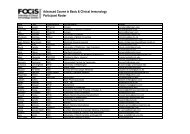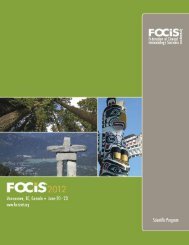Oral Presentations - Federation of Clinical Immunology Societies
Oral Presentations - Federation of Clinical Immunology Societies
Oral Presentations - Federation of Clinical Immunology Societies
Create successful ePaper yourself
Turn your PDF publications into a flip-book with our unique Google optimized e-Paper software.
S14 Abstracts<br />
<strong>of</strong> molecules that are likely to be critical to the<br />
maturation and function <strong>of</strong> DCs. In contrast, downstream<br />
NF-kappaB activity, DC maturation, and NEMO polyubiquitination<br />
were normal in EDI DCs following stimulation with<br />
the TLR4 ligand. These results show for the first time that<br />
CD40 and TLR4 use different signaling pathways to<br />
ubiquitinate NEMO, and <strong>of</strong>fer insight into how a mutation<br />
in the zinc finger domain <strong>of</strong> NEMO leads to pathway<br />
specific defects in NF-kappaB signaling and thus immune<br />
deficiency.<br />
doi:10.1016/j.clim.2007.03.208<br />
OR.28 Treatment <strong>of</strong> HIV-infected Patients with<br />
Vitamin D-binding Protein Derived Macrophage<br />
Activating Factor (GcMAF) Eradicates HIV-Infection<br />
Nobuto Yamamoto, Director, Socrates Institute for<br />
Therapeutic <strong>Immunology</strong>, Philadelphia, PA, Masumi Ueda,<br />
<strong>Immunology</strong>, Chief, Microbiology, Philadelphia, PA,<br />
Charles Benson, Head, Infectious Diseases, School <strong>of</strong><br />
Veterinary Medicine, University <strong>of</strong> Pennsylvania, Kennett<br />
Square, PA<br />
Serum vitamin D-binding protein (known as Gc protein) is<br />
the precursor for the principal macrophage activating factor<br />
(MAF). The MAF precursor activity <strong>of</strong> serum Gc protein <strong>of</strong><br />
HIV-infected patients was lost or reduced because Gc<br />
protein is deglycosylated by serum α-N-acetylgalactosaminidase<br />
(Nagalase) secreted from HIV-infected cells. Since<br />
Nagalase is the intrinsic component <strong>of</strong> gp120, serum<br />
Nagalase activity is the sum <strong>of</strong> enzyme activities expressed<br />
in both HIV virions and envelope proteins released from HIVinfected<br />
cells. Because <strong>of</strong> Nagalase being an HIV viral<br />
protein and immunogenic, serum Nagalase was already<br />
complexed with anti-HIV immunoglobulin G (IgG) in patient<br />
blood stream. These antibodies, however, were largely not<br />
neutralizing antibodies. The IgG-bound viral proteins<br />
retained Nagalase activity that deglycosylates Gc protein.<br />
Therefore, macrophages <strong>of</strong> HIV-infected patients having<br />
deglycosylated Gc protein cannot be activated, leading to<br />
immunosuppression. Stepwise treatment <strong>of</strong> purified Gc<br />
protein with immobilized beta-galactosidase and sialidase<br />
generated the most potent macrophage activating factor<br />
(termed GcMAF), which produces no side effect in humans.<br />
Macrophages activated by administration <strong>of</strong> GcMAF<br />
(100 ng/patient) develop a large amount <strong>of</strong> Fc receptors<br />
as well as enormous variation <strong>of</strong> receptors that recognize<br />
IgG bound and unbound HIV virions. Thus, macrophages<br />
activated by GcMAF preferentially phagocytize IgG-bound<br />
HIV virions via Fc receptor mediation. Cells latently<br />
infected with HIV are unstable and spontaneously release<br />
the virions at a high rate. After less than 18 weekly<br />
administrations <strong>of</strong> 100 ng GcMAF for twenty-one nonanemic<br />
patients, they exhibited low serum Nagalase activities<br />
equivalent to healthy controls, indicating eradication <strong>of</strong> HIV<br />
infection.<br />
doi:10.1016/j.clim.2007.03.209<br />
OR.29 Impaired In Vitro Regulatory T Cell Function<br />
Associated with Wiskott-Aldrich Syndrome<br />
Marsilio Adriani, Visiting Fellow, NIH/NHGRI, Bethesda, MD,<br />
Joseph Aoki, Visiting Fellow, NIH/NHGRI, Bethesda, MD,<br />
Reiko Horai, Postdoctoral Fellow, NIH/NHGRI, Bethesda,<br />
MD, Akihiro Kon, England Postdoctoral, Fellow, Bethesda,<br />
MD, Angela M. Thornton, Staff Scientist, NIH/NIAID,<br />
Bethesda, MD, Martha Kirby, Senior Research Assistant,<br />
NIH/NHGRI, Bethesda, MD, Stacie M. Anderson, Senior<br />
Research Assistant, NIH/NHGRI, Bethesda, MD, Richard M.<br />
Siegel, Investigator, NIH/NIAMS, Bethesda, MD, Pamela L.<br />
Schwartzberg, Investigator, NIH/NHGRI, Bethesda, MD,<br />
Fabio Candotti, Senior Investigator, NIH/NHGRI, Bethesda,<br />
MD<br />
Wiskott-Aldrich syndrome (WAS) is a primary immunodeficiency<br />
characterized by thrombocytopenia, eczema, recurrent<br />
infections and high incidence <strong>of</strong> malignancy. This disease is<br />
caused by mutations <strong>of</strong> the WAS protein (WASP) gene, a key<br />
regulator <strong>of</strong> actin polymerization. WAS patients show high<br />
incidence <strong>of</strong> autoimmune disorders (∼40–70%) the occurrence<br />
<strong>of</strong> which, however, does not correlate with the severity <strong>of</strong> the<br />
other classical hallmarks <strong>of</strong> the disease. A central question in<br />
understanding the pathophysiology <strong>of</strong> WAS is why immunodeficient<br />
patients develop symptoms suggestive <strong>of</strong> hyperactivation<br />
<strong>of</strong> immune compartments, such as eczema and autoimmune<br />
diseases. Since defects in CD4+CD25+ regulatory T cells (Treg)<br />
have been associated with autoimmunity, we examined the<br />
presence and function <strong>of</strong> these cells in WAS patients and Waspdeficient<br />
mice. Wasp-deficient patients and mice develop Treg<br />
cells that express Foxp3 with no detectable differences in<br />
frequency compared to controls. However, in vitro suppression<br />
assays showed that these Treg cells have impaired inhibitory<br />
function in vitro,which,inmice,couldonlybepartiallyrescued<br />
by pre-activation with exogenous IL-2. The demonstration <strong>of</strong><br />
impaired in vitro suppressor function in WASp-deficient Treg<br />
cells suggests that defective regulatory Tcell function may be an<br />
important factor contributing to immune dysregulation in WAS.<br />
doi:10.1016/j.clim.2007.03.210<br />
OR.30 Regulatory T Cell Abnormalities Associated<br />
with Aberrant CD4+ T Cell Responses in Patients<br />
with Immune Reconstitution Disease (IRD)<br />
Nabila Seddiki, Research Fellow, Centre For <strong>Immunology</strong><br />
and National Centre in HIV Epidemiology and <strong>Clinical</strong><br />
Research (UNSW), Darlinghurst<br />
Up to 30% <strong>of</strong> patients with HIV commencing antiretroviral<br />
therapy (ART) late in the disease restore a pathogen-specific<br />
cellular immune response that is immunopathological and<br />
causes disease referred as immune reconstitution disease or<br />
IRD. The immunopathogenesis <strong>of</strong> IRD is not well understood and<br />
is likely to be a consequence <strong>of</strong> an aberrant reconstitution <strong>of</strong><br />
certain T cell subsets. In a cross-sectional study, using HIV<br />
patients who developed mycobacterial IRD, we show that in<br />
comparison to those starting ARTand not developing IRD, CD4+ T<br />
cells specific for MTB and M. avium complex (MAC) antigens,<br />
produce high levels <strong>of</strong> IFN-g and IL-2 (Pb0.01) and proliferate<br />
strongly when compared to controls. We postulated that deficits<br />
in regulatory T cells (Tregs) numbers may play a central role in




